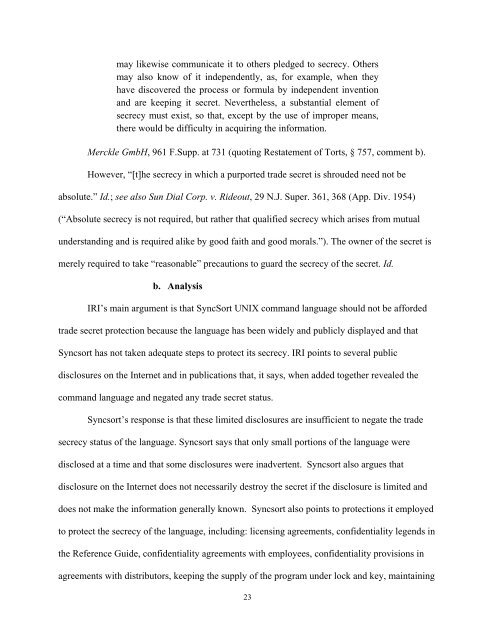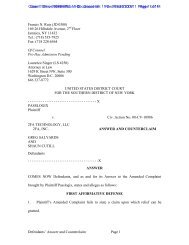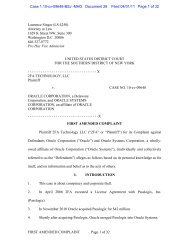Syncsort v. Innovative Routines.pdf - Trade Secrets Institute
Syncsort v. Innovative Routines.pdf - Trade Secrets Institute
Syncsort v. Innovative Routines.pdf - Trade Secrets Institute
- No tags were found...
You also want an ePaper? Increase the reach of your titles
YUMPU automatically turns print PDFs into web optimized ePapers that Google loves.
may likewise communicate it to others pledged to secrecy. Othersmay also know of it independently, as, for example, when theyhave discovered the process or formula by independent inventionand are keeping it secret. Nevertheless, a substantial element ofsecrecy must exist, so that, except by the use of improper means,there would be difficulty in acquiring the information.Merckle GmbH, 961 F.Supp. at 731 (quoting Restatement of Torts, § 757, comment b).However, “[t]he secrecy in which a purported trade secret is shrouded need not beabsolute.” Id.; see also Sun Dial Corp. v. Rideout, 29 N.J. Super. 361, 368 (App. Div. 1954)(“Absolute secrecy is not required, but rather that qualified secrecy which arises from mutualunderstanding and is required alike by good faith and good morals.”). The owner of the secret ismerely required to take “reasonable” precautions to guard the secrecy of the secret. Id.b. AnalysisIRI’s main argument is that SyncSort UNIX command language should not be affordedtrade secret protection because the language has been widely and publicly displayed and that<strong>Syncsort</strong> has not taken adequate steps to protect its secrecy. IRI points to several publicdisclosures on the Internet and in publications that, it says, when added together revealed thecommand language and negated any trade secret status.<strong>Syncsort</strong>’s response is that these limited disclosures are insufficient to negate the tradesecrecy status of the language. <strong>Syncsort</strong> says that only small portions of the language weredisclosed at a time and that some disclosures were inadvertent. <strong>Syncsort</strong> also argues thatdisclosure on the Internet does not necessarily destroy the secret if the disclosure is limited anddoes not make the information generally known. <strong>Syncsort</strong> also points to protections it employedto protect the secrecy of the language, including: licensing agreements, confidentiality legends inthe Reference Guide, confidentiality agreements with employees, confidentiality provisions inagreements with distributors, keeping the supply of the program under lock and key, maintaining23








